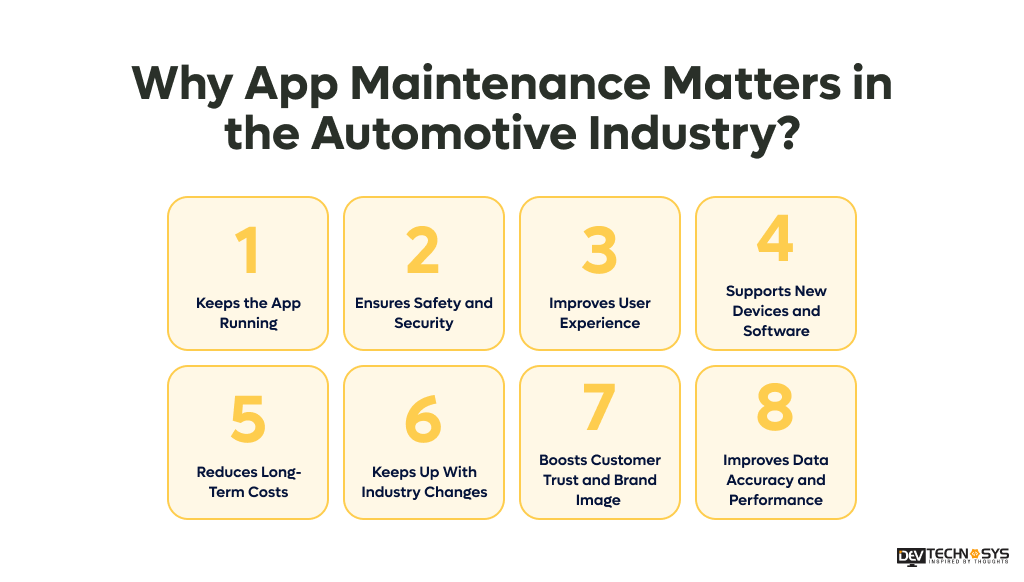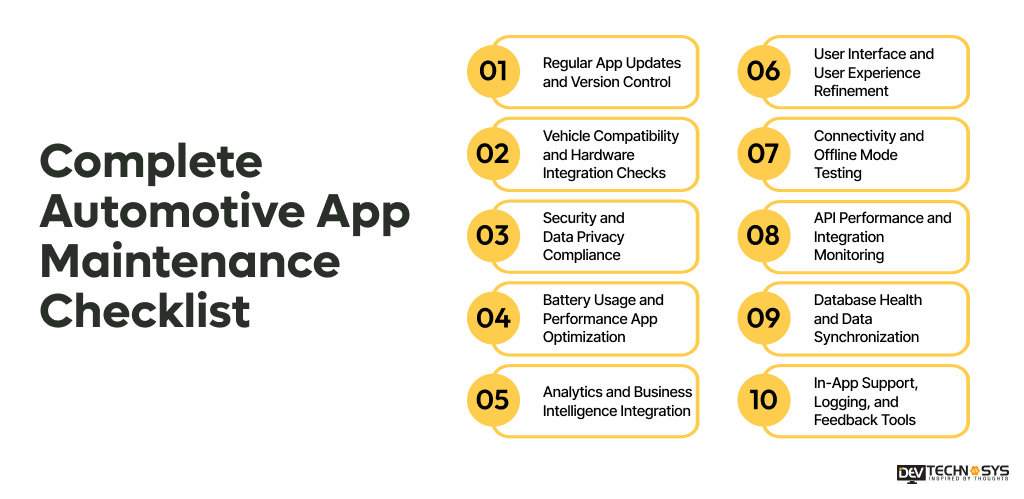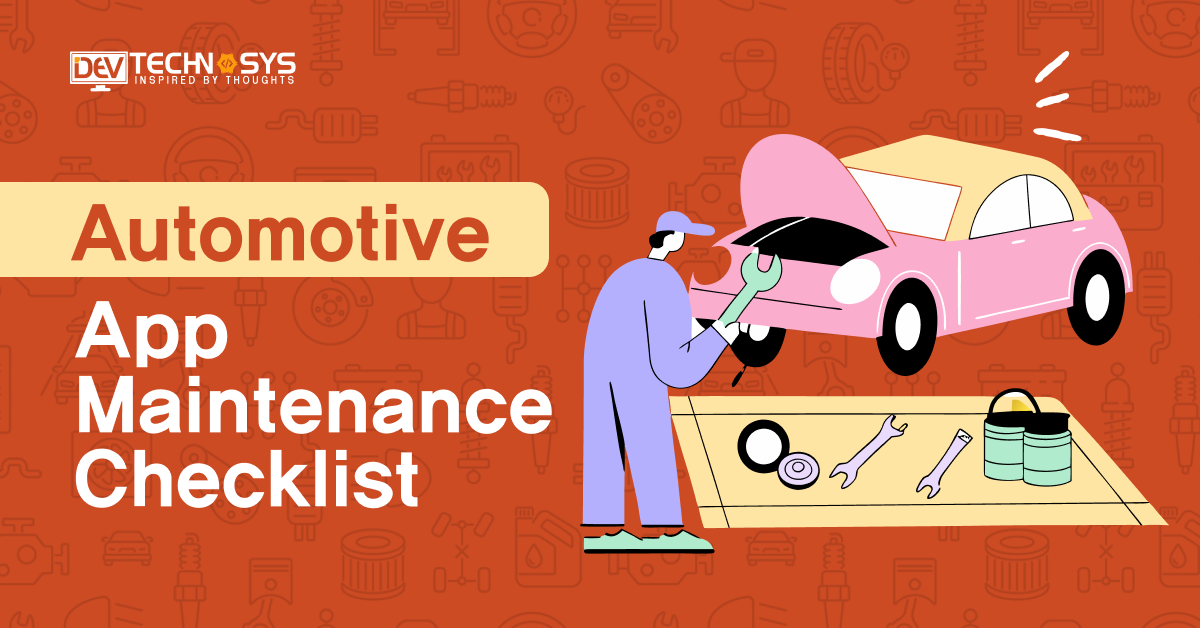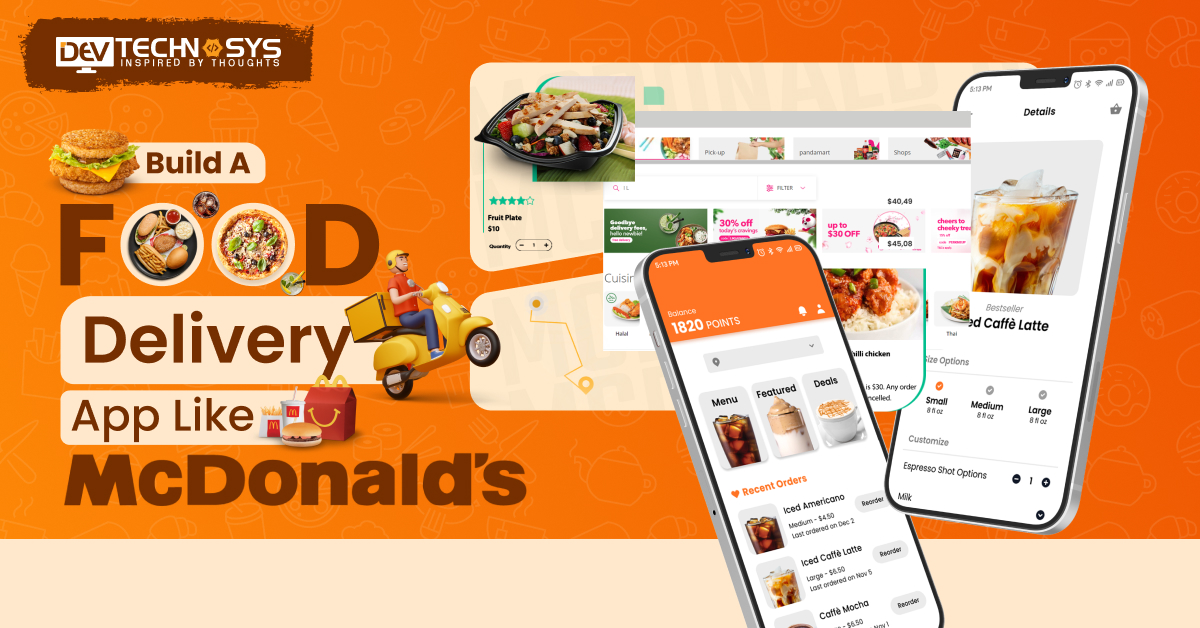In today’s fast-paced digital world, an automotive app is more than just a tool. It’s your customer’s garage in their pocket. Whether it helps users track maintenance schedules, find nearby service stations, or monitor vehicle diagnostics, your app plays a crucial role in their driving experience.
But even the smoothest ride needs a tune-up now and then. Just like a vehicle needs regular oil changes and inspections, your app needs consistent updates to stay secure, efficient, and user-friendly.
Overlooking maintenance can lead to bugs, poor performance, and frustrated users hitting the brakes on your platform. So, how do you ensure your app continues running like a well-oiled machine?
In this post, we’ll walk through a comprehensive automotive app maintenance checklist of what to look for during app updates, from performance improvements and UI enhancements to security patches and compatibility fixes. Let’s pop the hood and dive into smart app maintenance.
So, let’s begin!
Why App Maintenance Matters in the Automotive Industry?
In today’s world, mobile and web apps are at the heart of the automotive industry. From car manufacturers and dealerships to ride-sharing services and vehicle tracking, apps play a big role in how we interact with vehicles.
But when you develop a vehicle maintenance app, it isn’t enough; maintaining it regularly is crucial. Here are the simple but powerful reasons why app maintenance matters in the automotive industry.

1. Keeps the App Running Smoothly
Just like cars need regular servicing to run well, apps also need ongoing maintenance. If an app is not updated or maintained, it can slow down, crash, or stop working altogether.
This is especially risky in the automotive world, where people rely on apps for navigation, car diagnostics, booking services, or even controlling certain features of the vehicle. Maintenance helps avoid bugs and mobile app performance issues that can affect customer experience.
2. Ensures Safety and Security
In the automotive industry, safety is everything. Many automotive apps store sensitive user information like driving habits, locations, payment methods, and vehicle data.
Without regular updates, apps become vulnerable to cyberattacks. Hackers are always looking for weak points. By maintaining the app like Drivvo regularly, companies can fix security issues and protect their users’ data from theft or misuse.
3. Improves User Experience
A well-maintained app feels smooth, modern, and easy to use. Users expect a seamless experience, whether they are checking the battery level of their electric car, booking a service appointment, or tracking their fuel usage.
If the app is outdated or full of glitches, customers may stop using it. App maintenance helps keep the design fresh, features relevant, and usability high, which leads to better customer satisfaction.
4. Supports New Devices and Software
Every year, new phones, tablets, and car systems are released. At the same time, operating systems like Android and iOS get updates. If your app isn’t maintained to support these changes, it may not work properly or at all.
Regular website maintenance services ensure it is compatible with the latest devices and technologies, so users don’t run into problems.
5. Reduces Long-Term Costs
It might seem like an extra expense to maintain an app regularly, but in the long run, it actually saves money. Fixing small bugs early is much cheaper than dealing with major failures later on.
An unmaintained app might crash at a critical moment, leading to customer loss, reputation damage, or even legal trouble. Preventive maintenance helps avoid big, expensive problems.
6. Keeps Up With Industry Changes
The automotive industry is changing fast, with new trends like electric vehicles, connected cars, and autonomous driving. To stay competitive, companies need their apps to evolve, too.
An automotive app maintenance checklist allows businesses to quickly add new features, integrate with other systems, and keep up with changing customer expectations. It keeps the app relevant in a fast-moving market.
7. Boosts Customer Trust and Brand Image
When users see that a mobile app development company updates the app regularly, it shows professionalism and care. They feel more confident that the company is reliable and trustworthy.
On the other hand, an outdated or buggy app can make customers doubt the brand, even if the cars or services are excellent. Consistent app maintenance helps build a positive image and keep users loyal.
8. Improves Data Accuracy and Performance
Many automotive apps collect data from vehicles, such as fuel efficiency, engine health, or mileage. This data is used for service recommendations, fleet management, and more.
But if the app isn’t properly maintained, the data might become inaccurate or out of sync. Regular maintenance ensures that the app communicates correctly with vehicle systems and processes information smoothly.
Complete Automotive App Maintenance Checklist
Here’s an automotive app maintenance checklist, tailored for maintaining a robust, secure, and user-friendly automotive mobile or web application. This app update checklist covers technical, UX/UI, and business-related aspects to ensure your app remains efficient and up to date.

1. Regular App Updates and Version Control
Maintaining an automotive app requires consistent attention to updates and version control. This is perhaps the most critical part of your maintenance plan. Updates are not just about adding new features; they are essential for fixing bugs, improving performance, enhancing security, and keeping the app compatible with the latest devices and operating systems.
With the rapid evolution of mobile and web platforms, failure to update an app regularly can lead to crashes, poor user experiences, and even data vulnerabilities. It’s vital that you monitor release cycles from Android and iOS to plan ahead for changes in their APIs or permission models. A well-maintained app always aligns with the latest SDKs and frameworks.
Additionally, version control systems such as Git help keep a record of changes and allow your automotive software development company to track updates, roll back faulty deployments, and collaborate efficiently.
If your app includes backend services or APIs, these must also be version-controlled to avoid breaking integrations when changes are made. Regularly scheduled maintenance windows for deploying updates, whether monthly or quarterly, can help prevent issues and improve overall reliability.
2. Vehicle Compatibility and Hardware Integration Checks
Many automotive apps interact with vehicle systems through OBD-II ports, Bluetooth, or proprietary car APIs provided by manufacturers. These integrations must be continuously tested and updated as vehicle models evolve.
Maintenance in this area involves ensuring that your app works with the latest car firmware and app security updates and is compatible with a wide range of car makes and models. Hardware integrations often have edge cases that need handling, older cars may behave differently than newer ones, and regional versions of vehicles may support different protocols.
Testing across this diversity requires either access to multiple vehicle types or a robust simulation environment. Your automotive app maintenance checklist should include regular compatibility reviews and regression testing when new hardware or software updates roll out.
If your app provides services like remote start, keyless entry, or diagnostics, it’s crucial that these features work reliably and do not compromise vehicle safety. Maintaining partnerships with auto manufacturers and following their automotive app maintenance services can help you stay compliant and up-to-date.
3. Security and Data Privacy Compliance
Security is a cornerstone of any automotive app, especially those that collect sensitive information like driver behavior, vehicle health, payment details, or location history. Routine maintenance should include penetration testing, secure code reviews, and updating encryption protocols.
Ensuring compliance with data privacy laws such as GDPR, CCPA, and local regulations is not optional. It’s a legal and ethical requirement. A secure app builds trust with its users, and failure to maintain high security standards can lead to breaches that damage your brand and result in heavy fines.
Automotive app maintenance checklist in this area includes updating your app’s SSL certificates, ensuring HTTPS is enforced across all communications, and managing access control layers so only the right users can see or act on certain data. You can evaluate maintenance cost of mobile apps allowing sign-ins; it should also support secure login methods like two-factor authentication.
Over time, it’s also good practice to audit what user data you collect and whether it’s truly necessary, deleting outdated or unused information when appropriate. Building a culture of security awareness within your development team will also go a long way toward maintaining these standards.
4. Battery Usage and Performance App Optimization
Automotive apps often run in the background or rely on continuous data feeds, which can be heavy on battery usage. Users will quickly abandon an app that drains their phone battery or hogs memory and CPU.
Automotive software maintenance should include mobile app performance profiling on different devices to identify bottlenecks and areas of inefficiency. Tasks that consume a lot of power, like GPS tracking or Bluetooth connectivity with onboard vehicle systems, should be optimized to use as little energy as possible without sacrificing accuracy.
You can implement strategies like reducing app updates frequency when the app is in background mode or batching location requests. Your app should also be tested across a range of devices; older phones tend to have less memory and weaker CPUs, and your app should handle such limitations gracefully. Additionally, monitor crash logs and analyze user feedback to catch performance-related complaints.
Incorporating performance analytics tools can help you stay on top of resource usage trends and react proactively. Good mobile app performance maintenance not only improves user experience (UX) but can also increase the app’s star rating on app stores.
5. Analytics and Business Intelligence Integration
The final piece of an effective automotive app maintenance checklist is analytics. Understanding how your app is being used helps guide future improvements and refine your product roadmap. Maintenance in this area means regularly reviewing key metrics like user retention, session length, feature usage, and conversion rates.
If your app includes monetization features, such as service booking fees, ads, or in-app purchases, you should also track revenue streams and ROI. Analytics platforms should be updated along with your app so that new features are properly tracked. This often includes tagging events, setting goals, and validating that data flows correctly to your dashboards.
You can also use A/B testing frameworks to compare different versions of features or interfaces and make data-driven decisions. Maintenance ensures that these tools remain accurate and actionable, giving your team the insight they need to prioritize app bug fixes, develop a car repair and service app, new features, and refine the user journey.
6. User Interface and User Experience Refinement
Maintaining a smooth, intuitive, and attractive interface is another key part of automotive app upkeep. Over time, design standards evolve, and so do user expectations. An outdated or cluttered interface can drive users away. Routine UX audits should be part of your automotive app maintenance checklist.
This means evaluating how easy it is for users to complete key tasks, like locating their car, checking maintenance schedules, or booking service appointments. Feedback forms and app reviews can be goldmines of insight here. Does the app respond well to touch gestures? Are the fonts readable in sunlight, which is common in vehicle use?
Are menus intuitive and consistent? The application maintenance and support in this area might involve redesigning screens, reworking navigation flows, or updating icons and visual elements to align with modern trends. Remember that many users may be interacting with your app while on the go, so simplifying actions and reducing distractions is especially important.
Accessibility features, such as support for voice commands, screen readers, or high-contrast modes, should also be kept up-to-date to serve all users effectively.
7. Connectivity and Offline Mode Testing
Automotive apps often rely on continuous internet access, but what happens when users enter a tunnel, parking garage, or remote area with poor connectivity? Your app’s ability to handle offline conditions gracefully can make or break the user experience.
Automotive software maintenance should include offline mode testing to ensure key functions remain available even when the internet drops. This might mean caching recent trip data, allowing users to download maps, or queuing commands for vehicles to be sent when back online.
Apps should display appropriate messages during connectivity loss, guiding users instead of showing blank screens or crashing. If your app communicates with the car via Bluetooth or Wi-Fi, maintaining these communication layers is also critical.
You should regularly test different network conditions, using emulators and real-world driving scenarios, to ensure stable performance. By proactively app testing for cars and optimizing offline handling, you protect users from frustration and ensure they continue to trust your app, even in challenging environments.
8. API Performance and Integration Monitoring
A strong automotive app often connects with multiple APIs, be it for maps, weather conditions, telematics data, vehicle diagnostics, or payment gateways. Ensuring these APIs function smoothly is crucial.
Poorly performing APIs can slow down the app or cause complete feature failures, which leads to user frustration and poor ratings. Maintenance in this area involves monitoring response times, error rates, and data accuracy. Sometimes third-party APIs change or get deprecated, and you need to be ready with replacements or in-car app updates to your integration.
It’s also important to validate that API authentication and authorization systems are working properly to protect user data. In the automotive world, where real-time data can be crucial, like tire pressure or location tracking, API uptime becomes especially critical.
Maintenance should include app compatibility testing endpoints regularly, checking for expired tokens, and implementing retry logic or fallbacks when services are unavailable. Keeping detailed documentation of how your app integrates with these APIs also helps onboard a new Android app development company and mobile app troubleshooting faster.
9. Database Health and Data Synchronization
Behind the scenes of a well-functioning automotive app lies a carefully maintained database system. Whether it’s storing trip logs, maintenance records, or user profiles, the database must be optimized to handle growth over time.
Poorly indexed tables or unoptimized queries can lead to slow response times and even crashes. Regular database maintenance includes cleaning up stale or duplicate data, optimizing queries, backing up regularly, and ensuring your data models are scalable as usage increases.
For vehicle tracking apps that rely heavily on real-time data, synchronization between the app and server databases is especially important. If data is delayed or out of sync, users may see outdated information, causing confusion or distrust.
Maintenance should also include monitoring for data corruption and ensuring that sync conflicts are resolved automatically or with clear prompts to the user. By investing in a healthy data backend, you ensure your app remains reliable, responsive, and trusted over the long term.
10. In-App Support, Logging, and Feedback Tools
Supporting users effectively requires more than just a “Help” button. Ongoing app maintenance should include updating support channels, refining your in-app chat or ticketing systems, and reviewing logs to proactively address issues.
Adding features like FAQs, tutorial videos, or even AI-based help assistants can reduce support load and improve user satisfaction. Equally important is maintaining logs, application logs, crash logs, and API request logs, all of which give you valuable insight into how the app is performing and where problems are occurring.
These logs should be secure, anonymized, and accessible for analysis by your support and development teams. Furthermore, user feedback forms should be visible and simple to use. When users feel heard and supported, they’re more likely to stay loyal to your brand.
You should hire mobile app developers who can maintain these tools as your app evolves, ensuring that users can report bugs or issues relevant to the latest version.
Final Thoughts
Maintaining an automotive app is crucial to ensuring a smooth and reliable user experience. Regular updates help to fix bugs, enhance performance, and introduce new features. By staying on top of security patches, compatibility, and app usability, you can hire dedicated developers and provide users with a seamless ride.
Remember, just like a car needs regular tune-ups, your app thrives on consistent maintenance. With the right checklist, you’ll keep your app running as efficiently as a well-oiled machine, delivering the best experience for every user.
FAQs
1. Why is App Maintenance Crucial for Automotive Apps?
Maintenance ensures the app runs smoothly, improves user experience, and fixes bugs or security vulnerabilities.
2. What Should be Checked During App Updates?
Focus on bug fixes, performance improvements, new features, security patches, and compatibility with the latest operating systems.
3. How Often Should Automotive Apps be Updated?
App security updates should be scheduled regularly, ideally monthly or quarterly, to address bugs, enhance features, and stay secure.
4. What Security Measures Should be Implemented?
Ensure encryption, secure login protocols, and regular security audits to protect user data.
5. How Do I Test the App After an Update?
Test functionality, UI/UX flow, speed, and connectivity with automotive hardware to ensure seamless performance.
6. Should User Feedback be Considered?
Yes, user feedback helps identify areas of improvement and ensures the app meets customer needs effectively.
































